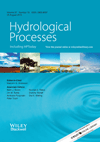Defining parameters for Eckhardt's digital baseflow filter
Abstract
Digital filters are useful tools for assessing the contribution of groundwater to total river flow. Several of those filters have been proposed in the last decades. One of the last contributions on this subject was given by Ekchardt (2005) who proposed a more general form of a digital baseflow filter and showed that some of the most used filters are special cases of this general form. This new filter has the inconvenience of having two parameters, one of them may be obtained directly from recession analysis, but the other (maximum baseflow index (BFImax)) is routinely estimated by a priori defined values according to the predominant geological characteristics of the drainage basin. In this short communication, we propose a method to estimate BFImax by a backwards filtering operation. The method was applied using data from 15 gauging stations in Brazil, with a varied range of groundwater contribution to streamflow. Results of the new estimation method for the BFImax parameter are coherent with the values which would be adopted by considering geological characteristics of the river basins. Copyright © 2012 John Wiley & Sons, Ltd.




